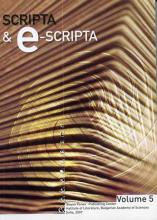Nikola Ikonomov
Milena Dobreva
Digitization Department at IMI-BAS: Three Years of Experience
-
Summary/Abstract
In 2004, when the Department for Digitization of Scientific Heritage was cre¬ated within the Institute for Mathematics and Informatics of the Bulgarian Academy of Sciences, several key areas of its work had been defined: general methodology and practical setting for digitization of cultural and scientific heritage; digitization of medieval manuscripts (incl. digital imaging, cataloguing, text representation, electronic publishing); digitization of mathematical texts; audio archives: methods for digitization and restoration; application of quantitative methods for the study of data related to the cultural heritage, and applications of edutainment to cultural heritage studies. This paper presents the development of the research and practical work in the last three years of the existence of the department when unique mixture of experience and competences on the Bulgarian setting were achieved. The paper concludes with ideas for future development.
